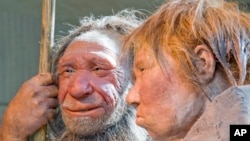Neanderthals may have saved time foraging for vegetation to eat, instead opting to eat the contents of herbivores’ stomachs, according to new research.
Researchers at the National History Museum in England theorize that plant material found on Neanderthal teeth could be from the partially digested stomach contents (chyme) of hunted animals.
“The practice of eating the stomach contents of prey could be a behavior that goes right back to the earliest humans,” said museum anthropologist Chris Stringer. “Having gone to the time and trouble of securing the carcass of a large herbivore, why would our ancestors have wasted such a source of nutrition?”
Eating stomach contents is still practiced today by Australian Aborigines, who eat the chyme of kangaroo and Greenland Inuit who consume the stomachs of reindeer as a delicacy.
In harsh conditions, such as desert or tundra, eating animal stomach contents allows people to gain nutrients from plants they could not easily obtain otherwise.
Neanderthals have long been thought of as pure big game hunters, largely ignoring vegetables and small game, a factor which, it has been argued, could have led to their extinction.
But new evidence from tooth plaque and other dietary analyses shows they did eat vegetation, including some that required complex preparation.
“It shows a level of dietary complexity not always appreciated before,” said anthropologist Laura Buck.
Stringer and Buck co-authored an article on their theory in the journal Quaternary Science Reviews.
Researchers at the National History Museum in England theorize that plant material found on Neanderthal teeth could be from the partially digested stomach contents (chyme) of hunted animals.
“The practice of eating the stomach contents of prey could be a behavior that goes right back to the earliest humans,” said museum anthropologist Chris Stringer. “Having gone to the time and trouble of securing the carcass of a large herbivore, why would our ancestors have wasted such a source of nutrition?”
Eating stomach contents is still practiced today by Australian Aborigines, who eat the chyme of kangaroo and Greenland Inuit who consume the stomachs of reindeer as a delicacy.
In harsh conditions, such as desert or tundra, eating animal stomach contents allows people to gain nutrients from plants they could not easily obtain otherwise.
Neanderthals have long been thought of as pure big game hunters, largely ignoring vegetables and small game, a factor which, it has been argued, could have led to their extinction.
But new evidence from tooth plaque and other dietary analyses shows they did eat vegetation, including some that required complex preparation.
“It shows a level of dietary complexity not always appreciated before,” said anthropologist Laura Buck.
Stringer and Buck co-authored an article on their theory in the journal Quaternary Science Reviews.







